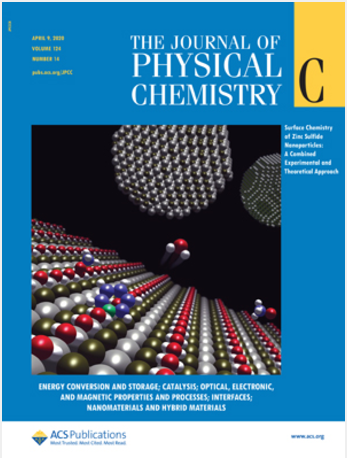Pressure- and Temperature-Dependence of Polar Nanoregions in KTN40 (KTa0.6Nb0.4O3) and KNbO3
IF 3.3
3区 化学
Q2 CHEMISTRY, PHYSICAL
引用次数: 0
Abstract
We investigated the pressure- and temperature-dependent phase transitions in KTN40 (KTa0.6Nb0.4O3) and KNbO3, two members of the perovskite-type ferroelectric solid solution system KTN (KTaxNb1–xO3), by heat capacity measurements, Raman spectroscopy, and second harmonic generation (SHG). The phase transition temperatures for the rhombohedral → orthorhombic → tetragonal → cubic sequence in KTN40 were determined to be 180(2) K, 225(2) K, and 295(2) K, respectively, by heat capacity measurements. For KNbO3, SHG measurements revealed orthorhombic → tetragonal → cubic transitions at 460(3) K and 720(3) K. In both compounds, SHG experiments indicated the presence of polar nanoregions within the cubic phase above the Curie temperatures of KTN40 and KNbO3. The dynamics and stability fields of these polar nanoregions were analyzed, resulting in Burns temperatures Td of 510(5) K for KTN40 and 1000(5) K for KNbO3. Intermediate temperatures, T*, where polar nanoregions begin to merge into larger domains, were identified for KTN40 and KNbO3 to be 350(5) K and 775(5) K, respectively. The pressure-dependent tetragonal → cubic phase transition was observed at 1.3(1) GPa for KTN40 and 15(0.5) GPa for KNbO3 using SHG. SHG measurements further confirmed polar nanoregions occurring in the cubic phase above the Curie pressures of KTN40 and KNbO3. Burns pressures pd were determined to be 6(1) GPa for KTN40 and 24(1) GPa and intermediate pressures p* were found at 1.8(2) GPa and 17(1) GPa, respectively. The known phase boundaries in temperature- and pressure-dependent phase diagrams could be reproduced and extended and phase diagrams could be enhanced by the addition of stability fields of polar nanoregions. It could also be shown that the dynamics of the polar nanoregions depend on chemical composition, as temperature-induced polar nanoregions in KTN40 appear to be smaller than in KNbO3. In addition, this study contains thermodynamic data for KNbO3, KTN40 and KTaO3. Based on the excess entropy for KTN40, these show that the formation of solid solutions tends to be favored in the KTN system compared to segregation.

KTN40 (KTa0.6Nb0.4O3)和KNbO3中极性纳米区的压力和温度依赖性
通过热容测量、拉曼光谱和二次谐波生成(SHG)研究了钙钛矿型铁电固溶体KTN (KTaxNb1-xO3)的两种成员KTN40 (KTa0.6Nb0.4O3)和KNbO3的压力和温度依赖相变。通过热容测量,确定了KTN40中菱形→正交→四方→立方序列的相变温度分别为180(2)K、225(2)K和295(2)K。对于KNbO3,在460(3)K和720(3)K的温度下,SHG测量显示了正交→四方→立方转变。在这两种化合物中,SHG实验表明,在KTN40和KNbO3的居里温度以上,立方相内存在极性纳米区。结果表明,KTN40和KNbO3的燃烧温度分别为510(5)K和1000(5)K。KTN40和KNbO3的中间温度T*分别为350(5)K和775(5)K,其中极性纳米区开始合并成更大的结构域。KTN40和KNbO3分别在1.3(1)GPa和15(0.5)GPa条件下发生了与压力相关的四方→立方相变。SHG测量进一步证实,在KTN40和KNbO3居里压力以上的立方相中存在极性纳米区。KTN40烧伤压力pd分别为6(1)GPa和24(1)GPa,中间压力p*分别为1.8(2)GPa和17(1)GPa。在温度和压力相关的相图中,已知的相边界可以被复制和扩展,并且通过极性纳米区稳定场的加入可以增强相图。研究还表明,极性纳米区域的动力学取决于化学成分,因为KTN40中温度诱导的极性纳米区域似乎比KNbO3中的小。此外,本研究还包含了KNbO3、KTN40和KTaO3的热力学数据。基于KTN40的过剩熵,这些结果表明,与偏析相比,KTN体系更有利于形成固溶体。
本文章由计算机程序翻译,如有差异,请以英文原文为准。
求助全文
约1分钟内获得全文
求助全文
来源期刊

The Journal of Physical Chemistry C
化学-材料科学:综合
CiteScore
6.50
自引率
8.10%
发文量
2047
审稿时长
1.8 months
期刊介绍:
The Journal of Physical Chemistry A/B/C is devoted to reporting new and original experimental and theoretical basic research of interest to physical chemists, biophysical chemists, and chemical physicists.
 求助内容:
求助内容: 应助结果提醒方式:
应助结果提醒方式:


